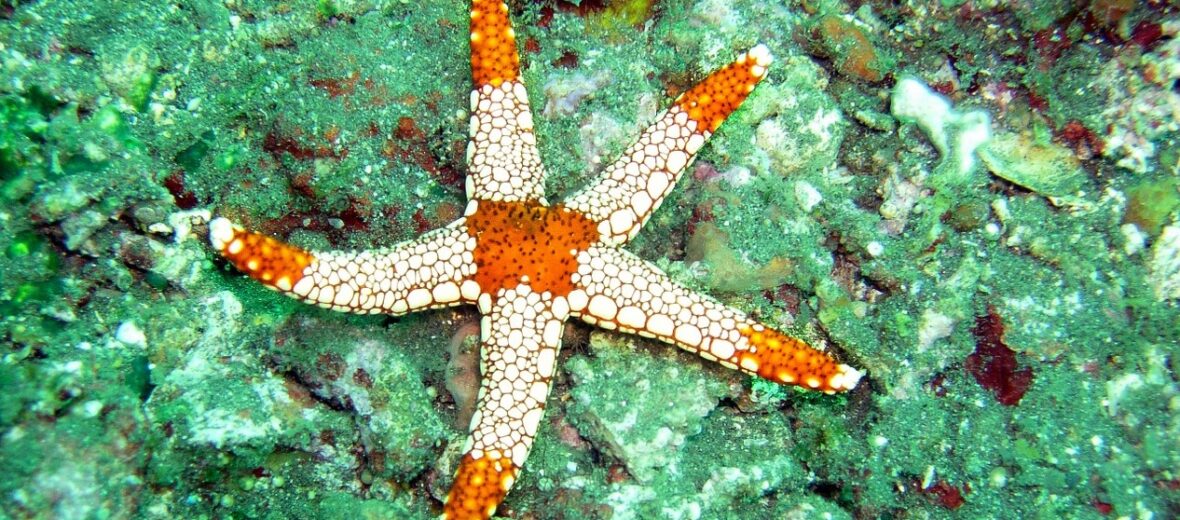
With approximately 2,000 known species of sea stars (aka starfish) in the world’s oceans, these creatures are well deserving of an article. This is generalized information about sea stars, as a whole. There will be more articles in the future about specific subspecies, like the crown of thorns sea star and more. They may be called starfish, but they actually belong to the phylum Echinodermata. That means they are related to sea urchins, sand dollars, sea cucumbers, and sea lilies; not fish. This particular phylum contains over 6,000 species.
First the Stats…
Scientific name: Asteroidea
Weight: Up to 11 lbs.
Length: Up to 3.3 feet across
Lifespan: Up to 35+ years
Now on to the Facts!
1.) Sea stars don’t always have just 5 arms. Some species have many more, like the sun star, which can have up to 40 arms!
2.) The surface of a typical sea star is covered with plates of calcium carbonate that have tiny spines on their surface. Their underbelly is lined with a mouth that also acts as an anus and hundreds of sticky tube-like feet.
3.) Many people also don’t know that the sea star eats with its stomach. It ejects its stomach from their body, engulfs the food and brings the food and stomach back into the body for digestion.
4.) Rather than blood, sea stars have a water vascular system made up almost entirely of sea water! The seawater is pumped into their watery vascular system through its sieve plate (a trap door called a madreporite), which is often seen as a light-colored spot on the top of the critter. From the madreporite, sea water moves into the sea star’s tube-like feet, causing the arm to extend. Muscles within the tube feet are used to retract the limb.
5.) They move via their tube feet. The tube feet are filled with sea water, brought in through the madreporite. They also use these tubes to grasp and hold onto food and to stick to surfaces, like rocks.
But wait, there’s more on sea stars!
6.) Starfish use what are called eye spots, located at the end of each arm, to see the world around them. They are basic eyes and merely see light and dark.
7.) These fascinating critters prey on bivalves like clams and mussels, as well as snails, small fish, and barnacles.
Did you know…?
Sea stars have most of their vital organs inside their arms. What this means is that some species can regenerate an entirely new sea star from just one arm and a small portion of the star’s central disc.
8.) Sea stars are able to reproduce sexually. They do this by expelling sperm and eggs (called gametes) into the water. The sperm comes into contact with and fertilizes the gametes and produces swimming larvae, which eventually settle onto the sea bed. Then they slowly grow into adult sea stars. Sea stars can also reproduce asexually (reproduction without a partner) through regeneration. This is what happens when the animals lose an arm.
9.) The Patiriella parvivipara is the smallest known sea star in the world.
10.) If lost or damaged, it takes about a year for a starfish to regenerate either an arm or a whole new starfish.
But wait, there’s still more on sea stars!
11.) The largest populations of starfish happen to live in both the Indian and Pacific oceans.
Did you know…?
There are no known starfish in fresh water systems. They die in water with too low of a specific gravity (salinity).
12.) Some of these creatures are hermaphrodites and some are gonochorous, in that they can change gender from male to female or female to male at any time. This helps to maintain their populations.
13.) Starfish can handle extreme ocean pressures. There have been sea stars found as far below the ocean’s surface as 18,000 feet deep!
14.) People in in China, Micronesia, and Japan eat sea stars. But you have to be careful as some sea stars are highly toxic.
Now a Short Sea Star Video!
Also, check out the Critter Science YouTube channel. Videos added frequently!
Want to suggest a critter for me to write about? Let me know here.



